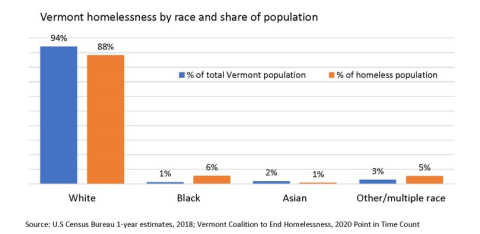Research conducted by VHFA for the 2020-2025 Vermont Housing Needs Assessment reveals that Vermont’s non-White households fare worse than White households according to numerous economic and housing-related metrics. Much of the data from the report is available on VHFA’s regularly updated Vermont housing data site.

Vermont is the second-least racially diverse state in the nation, with over 96% of its households headed by someone who is White alone, according to Census Bureau estimates. Only Maine has a smaller share of non-White residents. Vermont is also ethnically homogenous, with just 1.8% of the overall population identifying as Hispanic or Latino, compared to 18% nationally. However, Vermont is slowly beginning to become more diverse, with non-White households increasing by 1.4% since 2000.
Non-White Vermonters have considerably lower household incomes than White households. The median household income for White households is $58,244, compared to $41,553 for Black households. Non-White Vermonters are more likely to have low incomes, with 57% of Black households and 51% of Asian households earning less than 80% of their area’s median income, compared to only 43% of White households.
Income directly impacts the type and quality of home that a household can afford. Vermont has a disproportionately low homeownership rate among non-White households. Vermont’s homeownership rate among White households is 72%, while Black households have a rate of just 21%. This disparity is much larger than seen nationally, where 70% of White households and 41% of Black households are homeowners.
Non-White households are more likely to have what HUD labels ‘housing problems’, which means their homes lack complete kitchen facilities or plumbing, the home is overcrowded, and/or the household is cost burdened, paying more than 30% of income towards rent, mortgage payments and utilities. While a little over one third of White Vermont households have housing problems, around half of all Black, Asian, American Indian or “other race” households have housing problems.
Vermont’s unequal housing outcomes are particularly conspicuous among its homeless population. According to the 2020 Point in Time Count, 88% of the 1,110 homeless Vermonters were White, 6% were Black, less than 1% were Asian, and 5% were another race or multiple races. Vermont’s population as a whole is just 6% non-White, making non-White individuals overrepresented among its homeless population. Black Vermonters are especially overrepresented, making up barely 1% of Vermont’s overall population.
The roots of Vermont’s disparate housing outcomes are complex and far-reaching. With lower average incomes and wealth than White households, housing needs of non-White Vermonters are caused by decades of structural racism in national public policy, including systematized discrimination in housing, employment and education. This has led to generational wealth gaps between White and non-White households, which appear to be widening. Reversing this trend and achieving equal housing outcomes will require significant public investment, including but not limited to increasing rental and homeownership opportunities, expanded access to credit, reinforced consumer protections and rigorous enforcement of fair housing laws.

